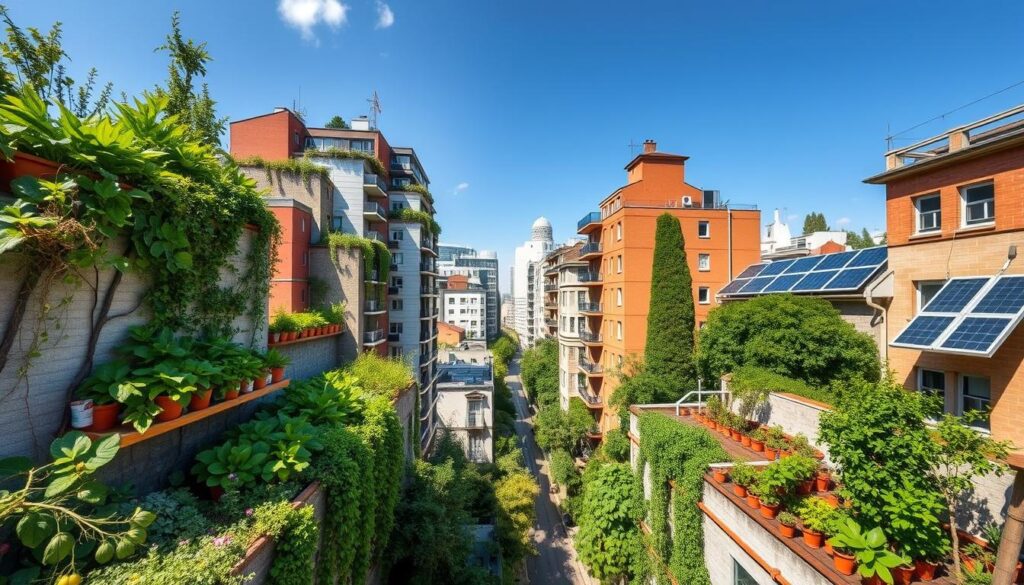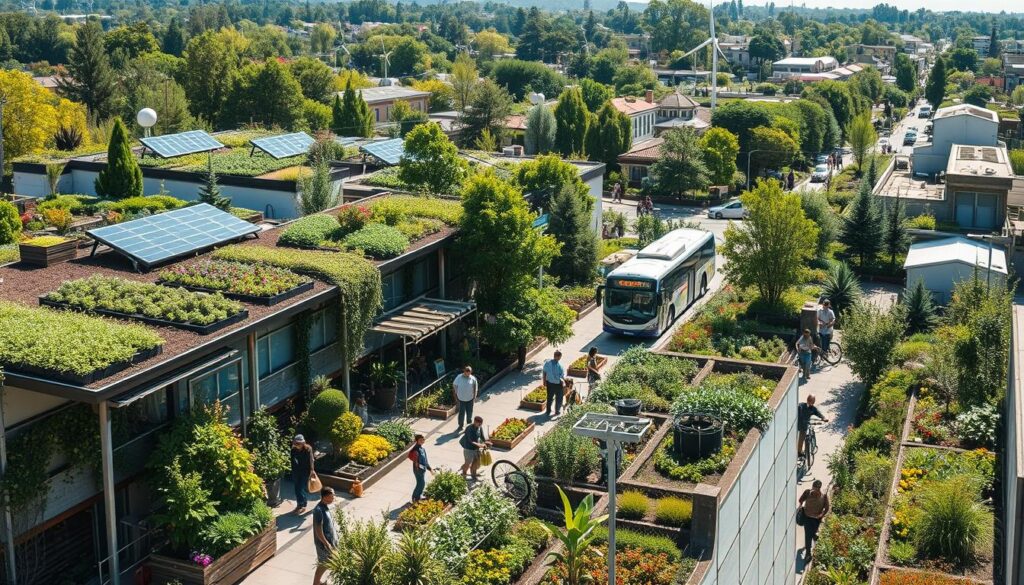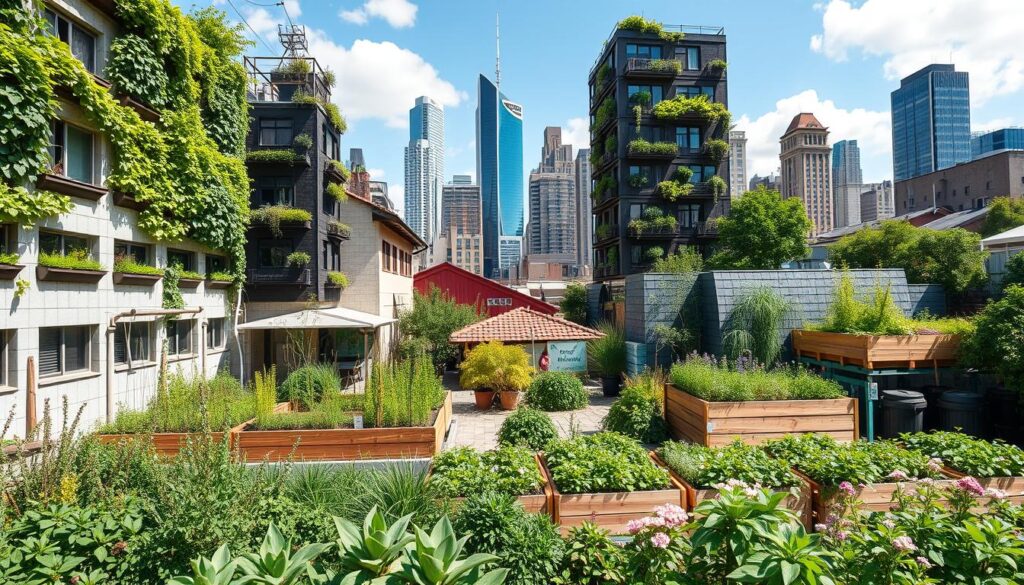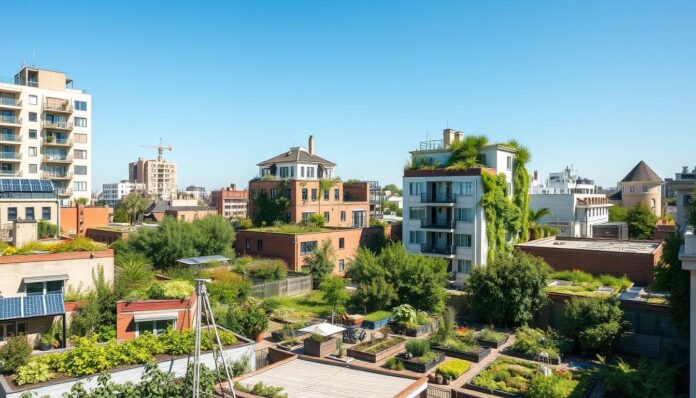Cities are growing fast, and we need to make them sustainable. Permaculture urban retrofitting is a way to make old urban areas green and healthy. It helps cities use less resources, grow more food, and make people happier. This method is crucial for building green communities.
David Suzuki says permaculture is key to solving big problems. It changes how we see and use city spaces. By using permaculture, cities can use less oil and live in better harmony with nature.
Permaculture makes cities better in many ways. It cools cities down and brings in more wildlife. As more people move to cities, using permaculture will become even more important. It’s a big step towards a greener future.
Key Takeaways
- Permaculture urban retrofitting offers a holistic approach to transforming existing urban spaces into sustainable environments.
- Permaculture principles can reduce urban heat, increase local biodiversity, and improve food security.
- Sustainable urban design is critical for creating resilient and thriving cities.
- Permaculture urban retrofitting can increase usable land for urban farming initiatives and reduce urban food deserts.
- Successful rainwater harvesting systems can meet nearly 100% of a garden’s irrigation needs during the dry season.
- Permaculture urban retrofitting is a key strategy for creating sustainable communities and reducing the ecological footprint of cities.
Understanding Urban Retrofitting in Permaculture
Urban retrofitting changes old urban areas to make them better for the planet. It uses ecological urban planning and urban permaculture principles. These focus on being green, saving resources, and boosting nature.
Being green is key in urban retrofitting. It helps the environment, keeps people healthy, and saves money. Some ways to be green include:
- Using less energy with green sources
- Water saving with smart systems and catching rain
- Creating green spaces and homes for wildlife
By using urban permaculture principles and ecological urban planning, cities can do better. They can cut down on harm to the environment, make people healthier, and build stronger communities.
| Strategy | Benefits |
|---|---|
| Reducing energy consumption | Less pollution, saves money |
| Conserving water | Less waste, cleaner water |
| Promoting biodiversity | Better air, more wildlife |
Core Principles of Permaculture
Permaculture is built on key principles like designing for sustainability and diversity in cities. It started in 1978 by Bill Mollison and David Holmgren. Now, it’s a worldwide movement aiming to make systems regenerative, self-sufficient, and strong. It focuses on green infrastructure solutions and urban sustainability techniques.
Using permaculture in cities can greatly help the environment and community. By making urban areas sustainable and diverse, they can become more resilient and lively. This is done with green infrastructure solutions like green roofs and urban gardens. They help increase biodiversity and lower the urban heat island effect.
Design for Sustainability
Designing for sustainability means making systems that can heal themselves, be self-sufficient, and strong. This is done by using renewable energy, efficient water systems, and eco-friendly materials. By doing this, cities can be made to have less environmental impact and support urban sustainability techniques.
Diversity in Urban Ecosystems
Having diversity in urban ecosystems is key for making them resilient and flexible. This is done by using many plant and animal species and creating different habitats. By increasing diversity in cities, they can become more sustainable and offer many benefits for people and the environment.
Benefits of Permaculture in Urban Settings
Permaculture in cities brings many benefits. It boosts food security, increases biodiversity, and lowers urban heat. Urban areas can turn into green, productive spaces by using permaculture.
Key advantages of permaculture in cities include:
- Enhancing food security through intensive cultivation and urban gardens
- Improving biodiversity by creating habitats for various species
- Reducing urban heat through green infrastructure and sustainable urban design
Permaculture can be used in small spaces like balconies and rooftops or in bigger areas like parks. It makes cities greener, more resilient, and better places to live.

As cities grow, the need for permaculture and sustainable design will grow too. Cities can become greener and better for people by using permaculture. This helps make the world more environmentally friendly and strong.
Strategies for Implementing Permaculture
Starting a permaculture project in the city needs careful planning. It’s about using urban permaculture principles to make green spaces that last. Vertical gardens and green walls are great for cooling down the city and making air cleaner. Adding green roofs and urban gardens helps fight the heat and brings in more life.
Setting up rainwater harvesting systems is another smart move. It can cut down water use by 50-70% compared to regular gardening. Using drip irrigation makes water use even better. Community gardens are also key, helping people work together and learn about growing food.
By using these methods, cities can become greener and stronger. Studies on earthquake-resistant permaculture show how permaculture helps communities get through tough times. It’s a step towards a better, more sustainable world.
The Role of Local Governments and Policies
Local governments are key in making cities green and sustainable. They create policies that help cities grow in a way that’s good for the environment. Ecological urban planning means designing cities with nature in mind. This includes using energy wisely, saving water, and managing waste well.
Local governments can encourage green development by offering help. This could be in the form of tax breaks or subsidies. For instance, a city might give a tax credit to buildings that use less energy or have green roofs.

Some important policies for green cities include:
* Laws that make neighborhoods walkable and mixed-use
* Incentives like tax breaks for green projects
* Investing in parks and green spaces
* Programs to teach people about living sustainably and reducing waste
These policies help make cities better for people and the planet.
Urban development typically looks to governments, local and national, to take the lead in transforming urban landscapes to promote sustainability and wellbeing.
Community Engagement in Urban Retrofitting
Community engagement is key for urban retrofitting success, focusing on permaculture urban retrofitting. Building local networks and encouraging community involvement helps. This way, people learn about the value of sustainable urban design and permaculture.
Some effective strategies for community engagement include:
- Organizing educational workshops and programs to provide training and capacity-building opportunities
- Creating community gardens and green spaces to promote sharing of resources and community interaction
- Developing community-led initiatives, such as verge gardens and urban food projects, to enhance food supply and community resilience
These efforts help community members feel a sense of ownership and responsibility. This leads to more sustainable and resilient urban areas. David Holmgren points out that changing behavior is crucial for adapting to energy challenges. Community engagement plays a big role in this change.
By encouraging community engagement and sustainable urban design, we can make cities better and more resilient. This supports the use of permaculture urban retrofitting principles.
| Strategy | Benefits |
|---|---|
| Community gardens | Enhanced food supply, community interaction, and education |
| Urban food projects | Increased community resilience, improved food security, and reduced waste |
| Educational workshops | Capacity-building, awareness-raising, and skill-sharing among community members |
Case Studies of Successful Permaculture Retrofitting
Urban permaculture has changed cities for the better. Detroit is a great example. It turned empty lots into farms, boosting food security and community spirit. New York City’s green roofs also show success, cutting down on heat and pollution.
These examples show why cities should use permaculture and green solutions. They help make cities better, cooler, and healthier. Green roofs and walls save energy and air, while farms give fresh food and bring people together.

- Improved food security through urban agriculture
- Enhanced biodiversity and ecosystem services
- Reduced urban heat island effect and improved air quality
- Increased community engagement and social cohesion
Learning from these examples, cities can make big changes. They can create green, thriving places for everyone. Using permaculture and green solutions makes cities better for the planet, people, and the economy.
Challenges to Integrating Permaculture
Bringing permaculture into cities is tough for many reasons. One big issue is money and resources. Ecological urban planning and urban sustainability techniques need a lot of money, which is hard for cities to find.
Another problem is when old-school developers don’t get permaculture. They might not want to change to green ways. But, teaching them can help cities use permaculture.
Some big hurdles in using permaculture in cities are:
- Lack of funding and resources
- Resistance from traditional developers
- Limited access to land and knowledge
But, many cities are making it work. They’re using permaculture and urban sustainability techniques to make cities better. By facing these challenges head-on, we can make cities greener and stronger for the future.
| Challenge | Solution |
|---|---|
| Lack of funding and resources | Seek government grants and private investments |
| Resistance from traditional developers | Provide education and training on permaculture principles |
| Limited access to land and knowledge | Establish community gardens and knowledge-sharing programs |
Tools and Techniques for Designing Permaculture Spaces
Designing permaculture spaces needs a good grasp of the tools and techniques. Permaculture urban retrofitting turns old urban areas into green, strong ecosystems. It starts with mapping urban landscapes. This means looking at the land’s shape, finding spots for permaculture, and designing systems that fit with nature.
Soil and water management are key in permaculture design. Sustainable urban design aims to manage water well, cut down on waste, and boost biodiversity. By using rainwater harvesting and greywater reuse, designers can lessen the need for city water and cut down on wastewater.
Tools like contour mapping and soil testing are used in permaculture design. Contour mapping shows where land is high or low. Soil testing tells about soil’s pH and nutrients. With these tools, designers can make green, strong ecosystems that help biodiversity and fight the urban heat island effect.
The Future of Urban Permaculture
Cities are growing fast, and urban permaculture is key for a sustainable future. Green roofs and urban gardens are leading the way. They bring new ideas and money into these fields.
The growth of urban permaculture is linked to new trends in green cities. Urban permaculture principles are now part of city planning. They aim to make cities productive and sustainable, balancing nature and community.
Trends in Sustainable Urban Development
Green walls and vertical gardens are big in sustainable cities. They help bring nature into the city and cool it down.
Innovations in Urban Green Spaces
New ideas in green spaces are shaping urban permaculture’s future. Urban composting and soil testing are part of it. So are small businesses like urban farms. These steps help cities become greener and stronger, benefiting everyone.
Successful Examples of Urban Retrofits
Urban retrofits have been a hit in many cities. They show how ecological urban planning and sustainability can work. These projects turn urban areas into green, thriving spaces.
For instance, eco-parks and greenbelts boost biodiversity and offer places for fun. Also, turning empty lots into green areas cuts down on heat and improves air quality.
Eco-Parks and Greenbelts
Eco-parks and greenbelts are great examples of urban retrofits. They follow ecological urban planning. These areas help nature, cut down pollution, and give people places to relax.
Transformations of Vacant Lots
Turning empty lots into green spaces is another success story. It gets rid of ugly spots and lets cities use green tech. This includes catching rainwater and adding green features.
Learning from these successes, cities can make better plans for urban retrofits. This leads to more sustainable and enjoyable places for everyone.
Measuring Success in Urban Retrofitting
Urban retrofitting uses permaculture to make cities better. It aims to make cities self-sufficient and green. To see if it works, we track things like energy use and how much carbon is released. We also listen to what people in the community say.
Permaculture urban retrofitting focuses on growing food, using renewable energy, and managing water. It also builds strong communities. For example, sustainable urban design can include green spaces and ways to save water and energy.
Some signs that urban retrofitting is working include:
- Less energy used and less carbon released
- More food grown locally and available
- Better water use and saving
- Stronger community bonds
By watching these signs and hearing from the community, we can make urban retrofitting better. This leads to better lives for city people, higher property values, and less harm to the environment.
Creating Educational Programs
Urban permaculture and green infrastructure need a well-educated community. Educational programs are key for sustainable urban growth. They help by working with schools and offering workshops for urban designers.
These efforts boost community strength against climate disasters. For example, engagement in permaculture education programs can increase urban biodiversity by 40%. Also, such programs can reach thousands of people each year, with over 5,000 participants across different platforms.
Successful programs like the Permaculture Educators Program teach many to become permaculture teachers worldwide. It supports global youth, women’s groups, and teens in refugee camps. Investing in education fosters a sustainable culture, driving innovation and green infrastructure investment.
Key benefits include:
- Increased community resilience against climate-related disasters
- Improved local biodiversity
- Enhanced food security
- Support for global youth initiatives and women’s self-help groups
By focusing on urban permaculture and green infrastructure, cities move towards a sustainable future.
The Global Perspective on Urban Retrofitting
Understanding urban retrofitting globally is key to building sustainable cities. By looking at international examples, cities can share knowledge and strategies. This helps them improve their urban planning and sustainability efforts.
Projects like green roofs and community gardens are making cities better. They make cities look good and help with food and biodiversity. These efforts make cities more livable and green.
Techniques like energy-efficient buildings and green transport are also important. They help cities cut down on pollution and make them cooler. Getting people involved in these projects is crucial for success.
Urban retrofitting offers many benefits. It improves air and water quality and boosts food security. It also makes cities more energy-efficient and green. By working together, cities can build a better future for everyone.
Conclusion: The Path Forward for Cities
As we wrap up our look at permaculture in cities, it’s clear that cities need sustainable solutions. The permaculture urban retrofitting way shows us how to make cities green and thriving.
The sustainable urban design ideas from permaculture ask us to rethink city planning. We can use green spaces, community projects, and new policies to make cities better. This way, cities can be places where people and nature live together well, with more food, biodiversity, and safety from climate change.
Now, it’s time for everyone involved to take action. Urban planners, policymakers, and citizens must work together. By doing so, we can make cities that are not just sustainable but also places where everyone thrives. Together, we can achieve a future where cities are models of balance and community strength.

